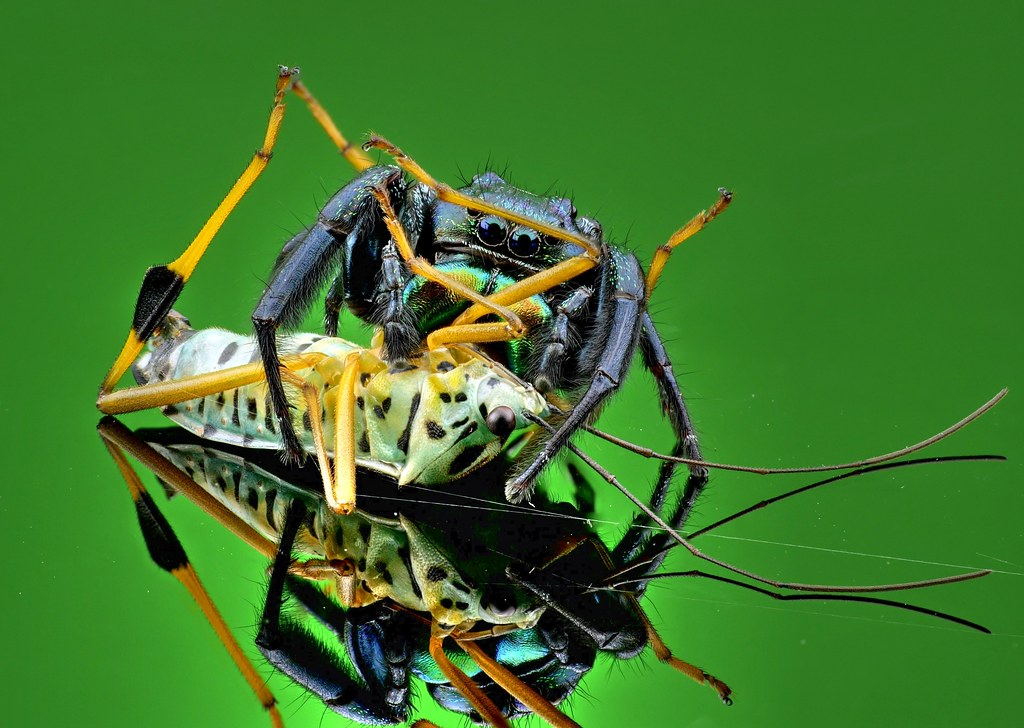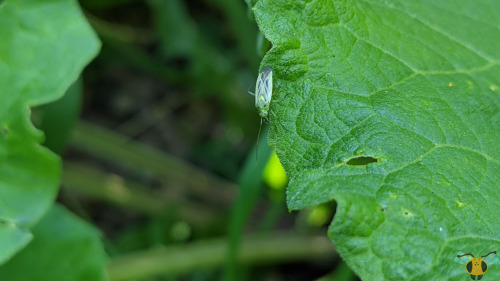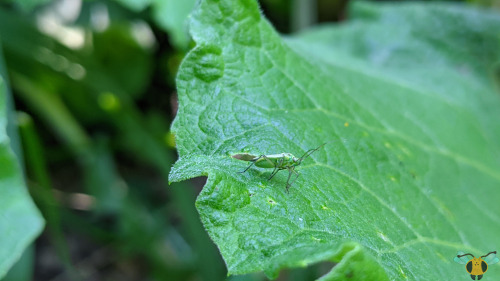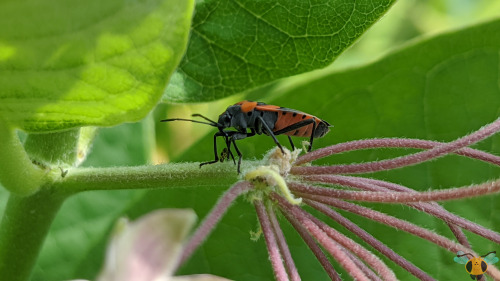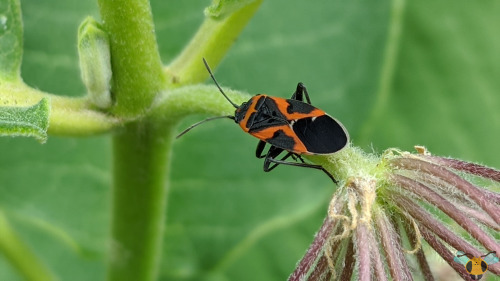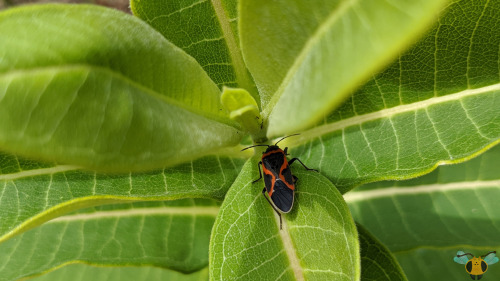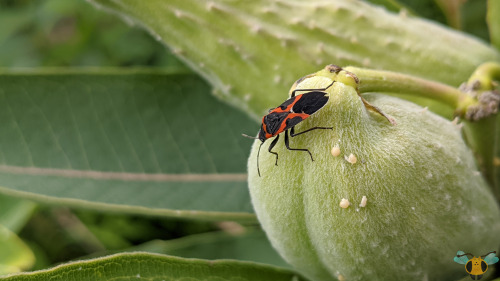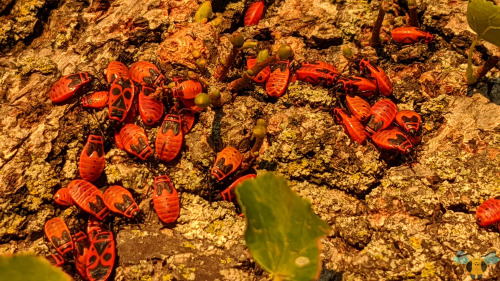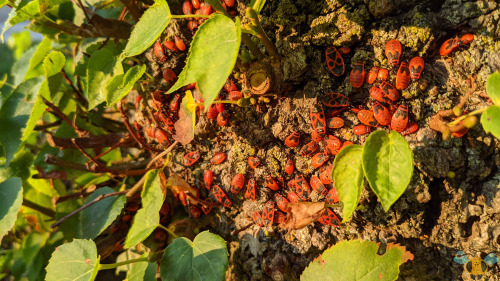#heteroptera
cotton stainer nymphs (Dysdercussuturellus,seed-feeding hemipterans best known for feeding on cottonseeds) squabbling over fallen seeds from a portia tree
(Florida, 2/6/21)
Chinese Insects and Spiders
…..and more
“TRUE” BUGS of China
Members of the Hemipteran suborder Heteroptera are known as “true bugs”. They have very distinctive front wings, called hemelytra, in which the basal half is leathery and the apical half is membranous. At rest, these wings cross over one another to lie flat along the insect’s back. These insects also have elongate, piercing-sucking mouthparts in which the mandibles and maxillae are long and thread-like, interlocking with one another to form a flexible feeding tube (proboscis) containing both a food channel and a salivary channel.
The immature stages of the heteropteran true bugs (nymphs) structurally resemble the adult form but are always lacking wings.
True bugs are generally well-known and include the stink bugs, assassin bugs, shield bugs, squash bugs and the aquatic water boatmen.
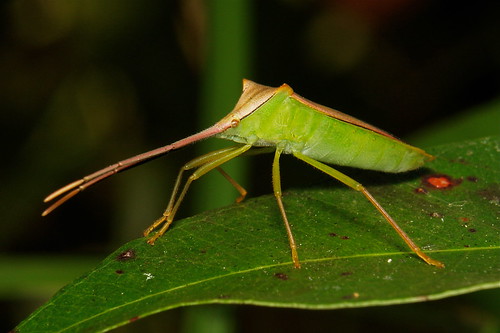

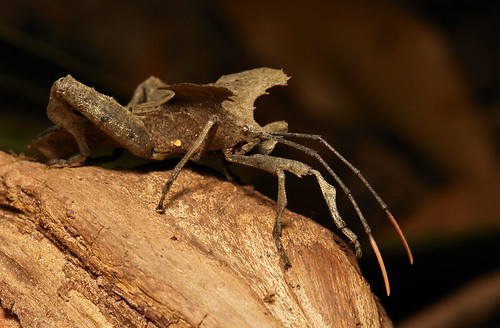

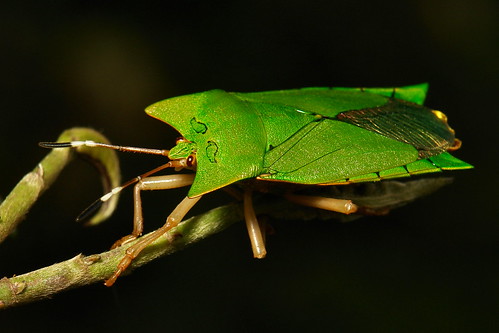
Click images to see identification (linked to their respective Flickr pages).
See others in the series of “TRUE” BUGS of China tumblr posts HERE.
bySinobug (itchydogimages) on Flickr.
Pu’er, Yunnan, China
See more Chinese true bugs and hoppers on my Flickr site HERE…..
Post link
Bee Assassin, Notocyrtus sp., Reduviidae by Andreas Kay
Via Flickr:
from Ecuador: www.youtube.com/AndreasKay
Jumping Spider, Parnaenus cyanidens & Leaf-footed Bug by Andreas Kay
Via Flickr:
from Ecuador: www.youtube.com/AndreasKay
Eastern Boxelder Bug - Boisea trivittata
I’ve developed a large stockpile of Boxelder Bug pictures to upload over the years, but despite how frequently I find them in my area, They’re some of the first insects to be food in the early spring (crawling in the leaf litter) and some of the last insects to grace the autumn (eventually making their way to the leaf littler); 2 generations make them easy to document and photograph. I’ve never sought to record them in motion. With today’s video, that changes. Taking a walk in a wooded area, I noticed that there were Boxelder Bugs galore! Not quite swarming, but there was tremendous activity on the goldenrod plants and in the dried grasses. Perhaps they were looking to secure territory and mating spots? The timeline would fit, and hopefully the nymphs are positioned near a suitable plant to satisfy them, While named after their host plant, it seems that maple tree juices are a source of food for them too! With this video, we can examine and observe how the insect moves on and reacts to the surfaces it struts along. While exploring the hand was a new experience for it, it seemed more than eager to return to the young goldenrods and hide from me. What interested me the most when revisiting the footage at home was how the insect’s antennae orient themselves when the Bug is on the move and at rest. It’s always sensing where to go next and getting a feel for its surroundings.
Video was recorded on May 19, 2022 with a Google Pixel 4. As well, B. trivittata will be known as the Eastern Boxelder Bug rather than just Boxelder Bug. This is to futureproof for later Boxelder Bug posts with new species. Prior posts have been adjusted to the reflect this change.
Two-Spotted Grass Bug - Stenotus binotatus
A green area filled with green grass, green leaves, and a certain green insect skitting around in this green world. With a bright green body, this specimen could have a much easier time hiding in your garden or the meadows that it calls home. You’d probably be better off searching for it in the meadow as there’s plenty of tall grasses for it to stick its rostrum into and enjoy. Yes, the Two-Spotted Grass Bug does in fact feed on grasses, but not the blades of grass that are seemingly more appetizing. Leaving the blades for the Grasshoppers to munch, this verdant Plant Bug uses its mouthparts to take nutrients from the clustering flowers of grass. As well, it isn’t too picky about the grass flowers it chooses to feed on whether a nymph or a full grown adult (like this specimen). The major difference is how to get to and from the food it needs since the nymphs lack wings. While known for feeding on grasses, they don’t seem to be generalists as they’ve been found feed on tree flowers too. With zebra grass growing in our neighborhood, I wonder if they have taken to that?
While named after the spots on their thorax plate, you could be forgiven for missing them by looking at the stripes that run down their wings. They certainly are lovely, but you have to look for those spot markings too. With look-a-like insect such as the Alfalfa Plant Bugand Ilnacora malina,it’s helpful to be sure which insects are flying around the meadow. With respect to the latter which is a dark green with a darker head, the Two-Spotted Grass Bug tends to be a paler green color with green on the top of its head. Although sometimes you may find a yellow-colored Grass Bug! What’s this! It seems that male S. binotatus tend to fall more on the yellow side while females tend to have that pale green color! Also, while I’m not totally sure, it seems that males have more their spots become gradually more prominent as they age, practically connecting with the markings on their back into one long line. I’ll need to find and review more specimens to be sure, and find more in person too! As with every insect I photograph, if I can find more, you’ll find them here, and I do sincerely hope that you enjoy them!
Pictures were taken on June 16, 2021 with a Google Pixel 4.
Post link
Brown Marmorated Stink Bug - Halyomorpha halys
So I’m working at my desk, doing research for an online course and I hear a noise. It sounds like a low buzzing, and it also sounds much larger than an Asian Ladybug, a more common visitor in my warm when spring’s warmth arrives. I turn around, that there’s a large flying body zooming around the lights and flying around the room with great haste! I thought it might be a Western Conifer Seed Bug since they’ve appeared in my room before, but it was flying too quickly to be sure. Couldn’t tell until it finally settled down, but there’s something about insects and light, and it keep circling the lamps. By this point, I had closed the door to prevent escape into the house. After a few minutes of flying around and tension growing, it crashed behind a set of drawers. Searching for it, I found the visitor on my tennis racquet, upon which I got a good look at it. A Stink Bug has awoken up for the spring! When I went to get my phone, the little Bugger took flight and began to buzz around the room again! Argh!! At least we know what it is now.
While it has a compact, shield-shaped body, it can be startling to see the full length of the wings for that split second before flight. When at rest, Stink Bug wings are folded against the abdomen, the forewings conceal the hindwings until it’s time to fly. It just wouldn’t be possible to maneuver that wide body without powerful wings, so when it’s time to go, the wings unfold out and get flapping. Getting back to the story, it resumed flying around the room aimlessly, eventually crash landing on top of the drawers this time. No slowing down, just crashing to an abrupt stop! Thank goodness an insect’s armored body allows for that, even if it may be too much for some other body parts to handle. Poor thing was missing a leg and an antenna. It could be tough to fly without all your instruments working. I picked it up in a glass and put it out the window (and without any spraying of stink) so that it wouldn’t be a bother indoors. Just a little story for today. Try not to be too nervous about the insects that decide to spend the winter in a warm house. They don’t mean to be bothersome, but they just can’t stand the cold. Quite relatable!
Pictures were taken on April 12, 2022 with a Google Pixel 4.
Post link
Small Milkweed Bug - Lygaeus kalmii
With Tuesday’s insect still fresh on our minds (Happy Valentine’s Day), I’m following it up with another black and red insect that has a similar appearance that one. The two are often confused for one another at first glance, but they have their differences in patterning and behavior once you get close enough. Common Firebugs have those large spots on their reduced wings, while today’s subject - the Small Milkweed Bug - has a red “x” pattern with black-colored bordering. Look for little simple eyes on the head of the Small Milkweed Bug too! These are called ocelli, and many other orders of insects have these too! These little ocelli are a big help for insects that need to get around by flying (since they help with the intake of information). However, just because Red Bugs lack ocelli, doesn’t mean they won’t fly, but some of them unfortunately wound up with reduced wings. Today’s showcase however, is a Seed Bug and can make great use of its wings to scale milkweed stalks and make a sudden escape if it’s been found tucked behind a seed pod. Though they may look similar to the Common Firebug (among others), their nesting and feeding habits have some differences.
You may see aggregations of the Small Milkweed Bug in an area dominated by flowers or scrounging around on the milkweed stalks, but the numbers will be much less. You’re more than likely to only find one or two, or maybe a mating pair? As they roam around the milkweed stalk, they search for the most valuable food sources they can: flowers and seeds! Some of the individuals in these photos have struck liquid gold! These milkweed flowers are ripe for the drinking, and using their straw-like rostrum, taking a sip can be done in a snap! Yeah they really like to get in there. While milkweed is the best choice here, they can drink from other flowers if they need to, especially if other insects swoop in a take all the nectar before they can. The milkweed pods are the next best target for all the seeds they house, making them valuable for eat and to lay eggs on. Depending on how fast your milkweed grows, you may want to monitor for these insects, but you can rest assured they pose little harm to your milkweed plants. They’ll share the territory with other milkweed dwelling insects, but it’ll be up to all of us to see if they bully other insects away from the delicious flower nectar.
Pictures were taken on July 2, 12, 21 and August 2, 2020 with a Google Pixel 4.
Post link
Firebug (aggregation) - Pyrrhocoris apterus
Valentine’s Day may have been yesterday, but we can still celebrate the day after with pictures of some delightful insects. Or perhaps, a whole army of them nestled in the sunlight and in the roots of this tree! It’s never easy to choose a red insect for such a day. Having already used the Red Milkweed Beetle and the Red Admiral to celebrate, I thought this year I would go with a very prominent and common Red Bug. Literally, for this Red Bug is indeed a Red Bug of the family Pyrrhocoridae, some of which are called stainers. Many of the insects in this family have beautiful red patterns (sometimes on the underside) highlighted with black markings. Here we find many individuals with these patterns in the different stages of their life cycle, though most are sub-adults, waiting for their final molt into winged adult. For the former, you can tell by the presence of black-colored wingbuds and a row of spots running down the abdomen of the Bug. Unfortunately things don’t really improve on the wing front (unless very lucky) into adulthood as Common Firebugs have reduced wings, compensated by a solid running speed. Though this aggregation looks intense for the afflicted tree, there is likely little danger to it as these insects feed on seeds and fruit.
This tree is likely just a resting spot for these insects to settle in after the sun sets. There are plenty of nooks and crannies to hide in until the next day. They likely aggregate together for the safety in numbers while waiting to fully mature. After mating, most of them will likely go their separate ways to place eggs in optimal locations. Sometimes that means a warm house interior, but they’re just doing what they do, and while they can seem like pests, they aren’t dangerous at all. If you find any in your home or garden, I don’t recommend crushing them, for you see they don’t find each other by running around and bumping into one another. They communicate using scents and chemical markers in the form of pheromones to bring everyone within range to the safe haven. Squishing them may only release more of the pheromone and invite more guests and/or suitors to the party! It may also leave a nasty stain behind too, which exemplifies the “stainer” name. The insects will need to be relocated and the area rinsed of pheromones if you don’t want them coming back. Gardeners may consider using the hose to get rid of them, but I think these insects are alright and it’s both interesting and amazing to see such a level of aggregation (and teamwork to some extend) in insects outside of those in a colony or a gregarious swarm.
Hope you all had a wonderful Valentine’s Day!
Pictures were taken on August 27, 2020 with a Google Pixel 4. These insects can also be seen in 2 videosuploaded earlier.
Post link
Shield-backed Bug - Pachycoris klugii
Pachycoris klugii (Heteroptera - Scutelleridae) is a common species in Mexico and Central America that in the past has been misidentified as P. torridus. It is an aposematic species that is brightly colored, with metallic green, and yellow, orange, or red spots. Extensive variation was observed in the color pattern of adults.
There have been several reports of maternal care in Heteroptera, according to Wilson (1979) it corresponds to a subsocial behavior in which the parent offers shelter with its body, carries the nymphs around on its back or venter, or simply stands close by. Maternal behavior was related to egg parasitism, habitat and host plant phenology.
Photo credit: ©Eduardo Axel Recillas Bautista | Locality: Hidalgo, Mexico (2008)
Post link



